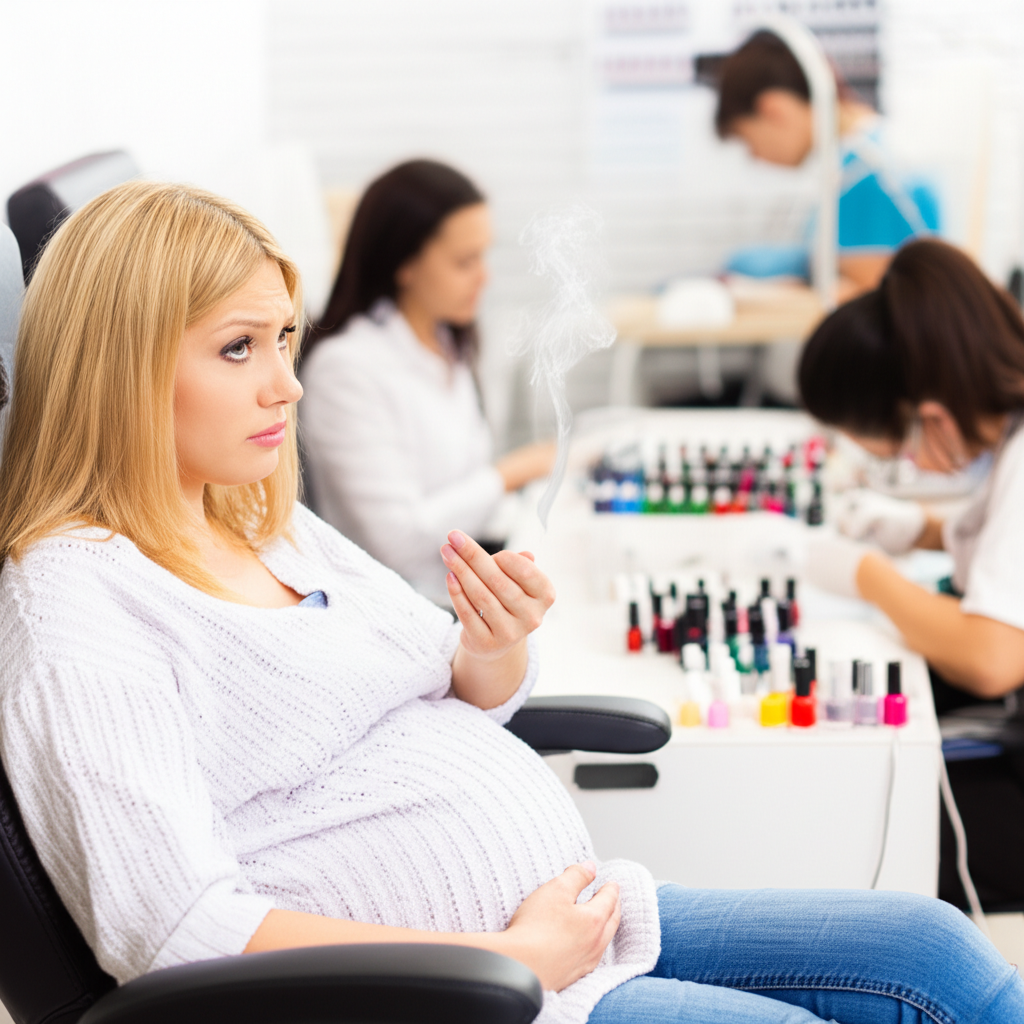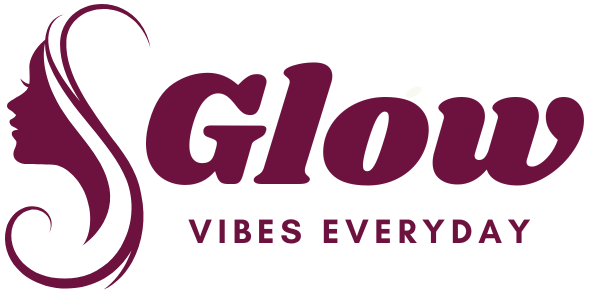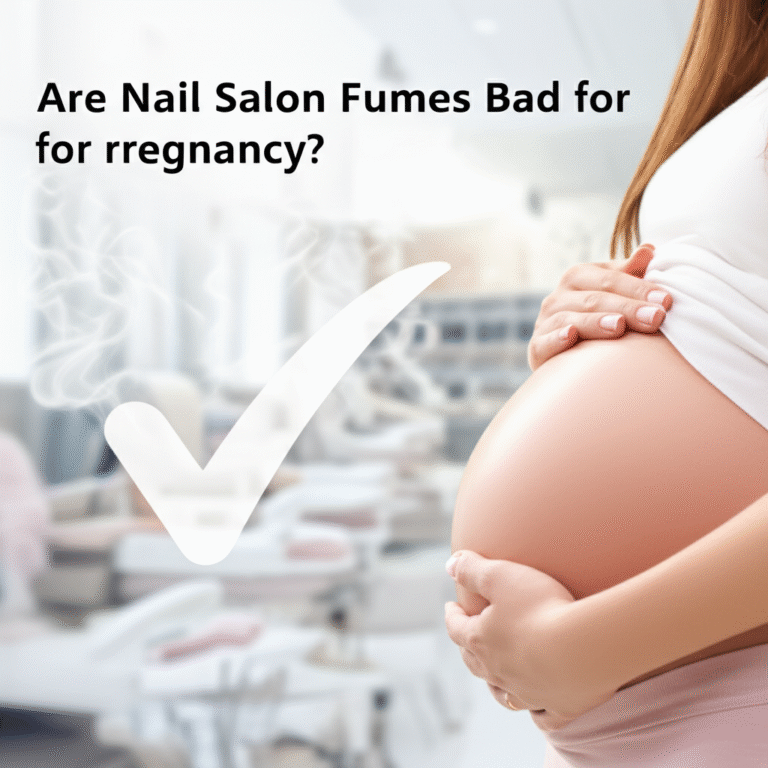Here’s the content you requested, focusing on the topic “Are Nail Salon Fumes Bad for Pregnancy? Yes!”:
—
A. Bolded Quick Summary
Yes, nail salon fumes can pose risks during pregnancy. Exposure to chemicals like formaldehyde and toluene can be harmful. Opt for water-based or low-VOC polishes, ensure excellent ventilation, and consider at-home manicures with breathable formulas to minimize risks.
—
B. Intro Paragraph
Expecting mothers often wonder about the safety of everyday activities, and a common concern revolves around visits to the nail salon. The strong, distinct smell that often fills these spaces can be a red flag, leaving many to question: are nail salon fumes bad for pregnancy? It’s a valid worry, as many beauty treatments involve chemicals that, while generally safe for the average consumer, might require extra caution when you’re nurturing new life. You’re in the right place to get clear, practical answers and discover how to enjoy beautiful nails safely throughout your pregnancy. Let’s dive into understanding the potential risks and explore the best practices for a healthy and happy glow.
—
C. Main Article Writing Instructions
Are Nail Salon Fumes Bad for Pregnancy? Understanding the Risks
Navigating pregnancy often means re-evaluating habits and products, and for many, this includes their regular trips to the nail salon. The potent chemical odors that are a hallmark of many manicures and pedicures can raise serious questions for expectant mothers. So, are nail salon fumes bad for pregnancy? The answer is a nuanced but important, yes. While a single, occasional visit might not pose a significant threat, regular or prolonged exposure to the volatile organic compounds (VOCs) and other chemicals commonly found in nail products can be a concern for both the mother and the developing fetus. Understanding these potential risks is the first step towards making informed choices.
The Chemical Cocktail: What’s in Nail Salon Fumes?

Nail salons are hubs of activity, offering everything from classic manicures to intricate acrylic and gel enhancements. However, the very products that create these beautiful results often contain a cocktail of chemicals. When these products are applied, cured, or removed, they release fumes into the air, which can be inhaled. The primary culprits of concern during pregnancy include:
Formaldehyde: A known carcinogen and sensitizer, formaldehyde is often found in nail hardeners and some traditional polishes. It’s used to strengthen nails and prevent chipping.
Toluene: This solvent helps to create a smooth finish and prevent polish from becoming too thick. However, toluene exposure has been linked to developmental problems and neurological effects.
Dibutyl Phthalate (DBP): Often referred to as the “toxic trio” along with formaldehyde and toluene, DBP is used to make nail polish more flexible and less prone to chipping. It’s considered an endocrine disruptor.
Methacrylic Acid: This is a key component in acrylic nail products and UV/LED gel polishes. While essential for their durability, its fumes can be irritating and potentially harmful with prolonged inhalation.
Acetone and Ethyl Acetate: These are common solvents used in nail polish removers. While generally less concerning in small, occasional exposures, high concentrations or frequent use can still contribute to overall chemical exposure.
These chemicals, when inhaled, can be absorbed into the bloodstream. During pregnancy, the body is working overtime to support fetal development, making it more susceptible to the effects of toxins.
Why are Nail Salon Fumes a Concern During Pregnancy?
The developing fetus is particularly vulnerable to chemical exposure. Certain chemicals found in nail products have been associated with:
Birth Defects: Some chemicals, like formaldehyde, are classified as teratogens, meaning they can potentially cause birth defects if exposure levels are high enough during critical periods of fetal development.
Developmental Issues: Exposure to solvents like toluene has been linked to neurological and developmental problems in infants, including lower birth weight and cognitive impairments.
Miscarriage: While research is ongoing and often based on occupational exposure studies, some studies suggest a potential link between high levels of exposure to certain chemicals and an increased risk of miscarriage.
Maternal Health: Pregnant individuals may experience increased sensitivity to these fumes, leading to headaches, nausea, dizziness, and respiratory irritation.
It’s important to emphasize that the risk is often dose-dependent, meaning the amount and duration of exposure play a crucial role. A single, infrequent visit to a well-ventilated salon is less likely to pose a significant risk than working in a salon for extended periods or having frequent, prolonged treatments in poorly ventilated spaces.
Myth Buster: “It’s just a little smell, what’s the big deal?”
While the smell might seem minor, it’s the invisible chemicals contributing to that odor that are the concern. These VOCs can linger in the air and be absorbed by your body. Think of it like secondhand smoke – the smell is an indicator of deeper, potentially harmful components.
Identifying “3-Free,” “5-Free,” and “10-Free” Nail Polishes
The beauty industry has responded to consumer concerns about nail product ingredients, leading to the development of “free-from” formulations. Understanding these terms is crucial for making safer choices:
3-Free: Typically free from Formaldehyde, Toluene, and Dibutyl Phthalate (DBP). This is the minimum standard for many seeking safer options.
5-Free: Free from the above three, plus Formaldehyde Resin and Camphor.
7-Free: Free from the 5-Free list, plus Xylene and Triphenyl Phosphate (TPHP).
10-Free (and beyond): These polishes go further, often excluding additional potentially harmful ingredients like parabens, ethyl tosylamide, and fragrances.
Table 1: Understanding “Free-From” Nail Polish Standards
| Standard | Excludes | Common Benefits |
| :——— | :——————————————————————– | :————————————————- |
| 3-Free | Formaldehyde, Toluene, DBP | Reduced exposure to key toxins |
| 5-Free | Formaldehyde, Toluene, DBP, Formaldehyde Resin, Camphor | Further reduction of sensitizers and irritants |
| 7-Free | Formaldehyde, Toluene, DBP, Formaldehyde Resin, Camphor, Xylene, TPHP | Avoids common irritants and potential endocrine disruptors |
| 10-Free+ | Formaldehyde, Toluene, DBP, Formaldehyde Resin, Camphor, Xylene, TPHP, Parabens, Ethyl Tosylamide, Fragrance (and potentially others) | Maximizes avoidance of common problematic ingredients |
Recommendation: When pregnant, aim for polishes labeled 7-Free or 10-Free for the safest option.
Safe Nail Care Practices During Pregnancy
The good news is that you don’t have to forgo manicures and pedicures entirely. By adopting a few key practices, you can significantly reduce your exposure to harmful fumes and enjoy beautifully maintained nails throughout your pregnancy.
At the Nail Salon:
1. Choose Your Salon Wisely:
Ventilation is Key: Opt for salons with excellent ventilation systems. Look for salons that have open doors or windows, or utilize local exhaust ventilation (hoods at each station).
Ask About Their Products: Don’t hesitate to ask the salon if they use “free-from” polishes or low-VOC products. Many salons are becoming more aware and accommodating.
Avoid Acrylics and Gels (if possible): These services often involve stronger chemicals and more intensive curing processes. If you love gels or acrylics, discuss with your technician about using their least-fume-intensive products and ensure maximum ventilation.
2. Communicate Your Needs:
Inform Your Technician: Let your nail technician know you are pregnant. They may be able to suggest specific products or techniques that are safer.
Request Specific Products: If you have “free-from” polishes at home, you can bring them to the salon to be used for your service.
3. Minimize Inhalation:
Sit Near a Window or Door: If possible, choose a seat that’s not in the most concentrated fume area.
Hold Your Breath Briefly: For short periods, like when polish is being applied or removed, you can gently hold your breath or breathe through your mouth.
4. Consider Alternatives:
Water-Based Polishes: These are becoming more popular and offer a very low-odor alternative, though they may not be as durable as traditional polishes.
Nail Wraps or Stickers: These often involve fewer chemicals and no drying time or fumes.
At-Home Manicures:
DIY manicures can be a safer and more convenient option during pregnancy, provided you make conscious product choices.
1. Choose Your Products Carefully:
Opt for “10-Free” or “7-Free” Polishes: These are widely available from various brands and offer a much safer ingredient profile.
Use Low-Odor Removers: Look for acetone-free or soy-based nail polish removers.
Consider Breathable Polishes: These polishes allow moisture and air to pass through, potentially leading to healthier nails and less chemical buildup.
2. Ensure Proper Ventilation:
Open Windows and Doors: Always do your nails in a well-ventilated area. If it’s not possible to open windows, consider using a small fan to direct fumes away from you.
Avoid Small, Enclosed Spaces: Don’t do your nails in a tiny bathroom with the door closed.
3. Step-by-Step At-Home Manicure with Safer Practices:
Step 1: Prepare Your Workspace. Find a well-lit, well-ventilated area. Lay down an old towel or newspaper to protect surfaces. Have all your supplies within reach.
Image Placeholder: A clean, organized workspace with nail polish, remover, cotton pads, files, and buffers.
Pinterest Idea: “Safe DIY Pregnancy Manicure Station” – flat lay of eco-friendly nail products, essential oils for scent, and a fan.
Alt Text: “DIY pregnancy manicure station setup with natural light and ventilation.”
Step 2: Remove Old Polish. Use an acetone-free or soy-based nail polish remover and cotton pads. Gently wipe away old polish.
Image Placeholder: Close-up of hands removing nail polish with a gentle remover.
Pinterest Idea: “Gentle Nail Polish Removal for Pregnancy” – demonstration of using soy-based remover.
Alt Text: “Removing nail polish with acetone-free remover during pregnancy.”
Step 3: Shape and File. Gently file your nails into your desired shape. Always file in one direction to prevent splitting and weakening.
Image Placeholder: Hands filing nails with a glass or fine-grit file.
Pinterest Idea: “Perfect Nail Filing Technique for Healthy Nails” – step-by-step filing guide.
Alt Text: “Filing nails to a smooth shape using a fine-grit file.”
Step 4: Cuticle Care. Gently push back cuticles with an orange stick or cuticle pusher. Avoid cutting cuticles, as this can lead to infection. Apply a cuticle oil or balm to nourish them.
Image Placeholder: Hands gently pushing back cuticles with an orange stick.
Pinterest Idea: “Pregnancy-Safe Cuticle Care Routine” – gentle cuticle treatment.
Alt Text: “Gently pushing back cuticles with an orange stick for nail health.”
Step 5: Apply Base Coat. Use a “7-Free” or “10-Free” base coat. This protects your nails from staining and helps polish adhere better.
Image Placeholder: Applying a clear base coat to nails.
Pinterest Idea: “Best Base Coats for Pregnancy Manicures” – showcasing 10-free base coat options.
Alt Text: “Applying a 10-free base coat to protect nails.”
Step 6: Apply Color. Apply two thin coats of your chosen “7-Free” or “10-Free” nail polish. Allow each coat to dry slightly before applying the next.
Image Placeholder: Applying a colored nail polish with even strokes.
Pinterest Idea: “Beautiful Pregnancy-Friendly Nail Colors” – swatches of pastel or muted tones in 10-free polish.
Alt Text: “Applying a thin, even coat of pregnancy-safe nail polish.”
Step 7: Apply Top Coat. Finish with a “7-Free” or “10-Free” top coat to seal the color, add shine, and extend the life of your manicure.
Image Placeholder: Applying a clear top coat to seal the manicure.
Pinterest Idea: “Long-Lasting Top Coats for DIY Manicures” – highlighting non-toxic top coat benefits.
Alt Text: “Sealing a manicure with a 10-free top coat for shine and durability.”
Step 8: Clean Up. Use a small brush dipped in remover to clean up any polish that got on the skin around your nails.
Image Placeholder: Using a small brush to clean up nail polish edges.
Pinterest Idea: “Professional Manicure Cleanup at Home” – tips for neat nail polish application.
Alt Text: “Cleaning up nail polish edges with a small brush and remover.”
Step 9: Dry and Moisturize. Allow nails to dry completely. Once dry, apply cuticle oil and hand cream to keep skin hydrated.
Image Placeholder: Applying cuticle oil and hand cream to finished nails.
Pinterest Idea: “Nourishing Hand and Nail Care Post-Manicure” – pampering tips.
Alt Text: “Moisturizing hands and cuticles after a pregnancy-safe manicure.”
Pro Tip for Gel and Dip Powder During Pregnancy:
If you are fond of gel or dip powder manicures, consider scheduling them for the second or third trimester rather than the first. This is because the first trimester is a crucial period for organ development, and it’s generally advisable to be most cautious during this time. Always ensure the salon has excellent ventilation and discuss using low-odor, low-VOC products if available. Some salons offer “water-based” gel polishes, which can be a safer alternative.
When to Seek Professional Advice
While these guidelines aim to provide comprehensive information, it’s always best to consult with your healthcare provider regarding any specific concerns about chemical exposure during pregnancy. They can offer personalized advice based on your health history and circumstances.
Product Recommendations for Safer Nail Care
Choosing the right products can make a significant difference. Here are some highly-regarded brands known for their “free-from” formulations:
Table 2: Recommended “Free-From” Nail Polish Brands
| Brand Name | “Free-From” Standard | Key Features | Affiliate Link Placeholder |
| :—————- | :——————- | :————————————————————————- | :————————- |
| Ella + Mila | 17-Free | Vegan, cruelty-free, chip-resistant, wide range of colors, quick-drying. | [Shop Ella + Mila] |
| Zoya | 10-Free | Long-wearing, extensive color library, professional quality, non-toxic. | [Shop Zoya] |
| Butter London | 10-Free | High-shine finish, strengthening ingredients, stylish colors, vegan. | [Shop Butter London] |
| Côte | 10-Free | 100% Vegan & Cruelty-Free, salon-quality, chic packaging, gentle formulas. | [Shop Côte] |
| Mineral Fusion| 5-Free | Mineral-based, infused with antioxidants, affordable, natural beauty focus.| [Shop Mineral Fusion] |
Pro Tip: Look for brands that clearly list their ingredients and their “free-from” claims on their website or packaging. Transparency is a good indicator of a brand’s commitment to safer formulations.
Frequently Asked Questions (FAQ)
Q1: Is it safe to get my nails done at a salon once a month during pregnancy?
A1: For most healthy pregnancies, an occasional visit to a well-ventilated salon using reputable products is generally considered low risk. However, it’s always best to discuss this with your healthcare provider. Prioritizing salons with excellent ventilation and asking about their product lines is recommended.
Q2: Are gel manicures safe during pregnancy?
A2: Gel manicures typically involve stronger chemicals and UV/LED curing. While generally considered safe with proper ventilation and minimal exposure, some expectant mothers prefer to avoid them or opt for water-based gel alternatives. Discussing this with your salon and doctor is advisable.
Q3: What is the safest type of nail polish to use when pregnant?
A3: The safest options are “10-Free” or “7-Free” nail polishes, especially those that are water-based or specifically formulated for sensitive individuals. Always ensure good ventilation when applying any nail polish.
Q4: Can I use regular nail polish remover?
A4: It’s best to avoid removers containing harsh chemicals like acetone, especially if you are sensitive or concerned about fumes. Opt for acetone-free or soy-based removers, which are gentler and have less potent odors.
Q5: My salon uses a strong chemical smell. Should I be worried?
A5: A strong chemical smell indicates a higher concentration of VOCs in the air. If you are pregnant, this is a sign to be cautious. Look for salons with better ventilation or consider doing

